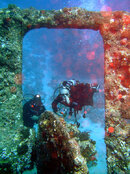This is taken from the website of joe liburdi.
Dive Travel with Joe Liburdi He has been diving for 55 years, most of you know him, he's been my mentor and I've adopted him as my dad. He gives private underwater photo lessons for new photographers, or people that want to improve.
Greetings!
Welcome to our monthly newsletter designed to keep you informed of the goings on in the wonderful world of Digital Photography and Video. We hope you find this of interest and if you have a topic you would like us to cover in future newsletters, please let us know.
Composition
Photography is an art.Those who do it well are artists.
But not everyone who cradles a camera becomes a good photographer and no one person knows everything there is to know about photography. The majority of the population on our planet owns at least one camera and I dare say that 90% of them are clueless on how to compose a picture pleasing to the eye.
My knowledge about photography stems from trial and error, chat sessions with the pros, and many hours of reading about photography.
Our modern camera systems have all the automatic gadgetry to make life easy for the photographer. But for all the bells and whistles and sophisticated technology, a camera cannot compose the image in front of the lens into a work of art. Art must originate from the human brain. Thats why no two photographers will create a photo of the same likeness.
The basic rules of composition that follow are guidelines and are meant to be stepping stones. With a little bit of practice and honing of the skills, you will become a better photographer, possibly a great one.
We will discuss two of the basic rules in photographic composition.
Fill the frame with a clear description of the central point of interest. Get in as close as possible and frame only the central point of interest. Eliminate any distracting images in the scene that are not pleasing to the eye.
Practice The Rule of Thirds. Mentally divide the frame in thirds both horizontally and vertically. The central point of interest being photographed should be placed either one third across or one third up or down the picture, or where the lines intersect.
FAQs
Q: Whats with the black dots that appear in the same spot on all my digital images?
(personal conversation red dots the same)
A: Chances are, they are dust particles on the cameras CCD sensor. The electrically charged CCD radiates static energy and the dust adheres to the sensor.
Prevention
Always turn the power off on the camera before changing lenses.
Always change lenses in a clean windless environment. Use extreme caution when changing lenses on a boat or beach. Sea spray and sand are extremely hazardous to the electronics of your camera when the lens is removed.
When using your camera in dusty, windy conditions, always cover the camera between shots. Keep it covered as much as possible.
Cure
Most camera manuals have instructions on how to clean the CCD. Follow the instructions to the letter!
Visit the web. There are many sites with good ideas on materials and instructions on cleaning sensors.
Cleaning a sensor is a delicate operation. If you are not skilled with working with your hands, send the camera into the factory or repair center for professional help.
If you dont want the hassle of cleaning the sensor, use Photoshop to eliminate the spots from your pictures. However, this is a hassle and is not a really good solution. GET THE SENSOR CLEANED AND KEEP IT CLEANED.





